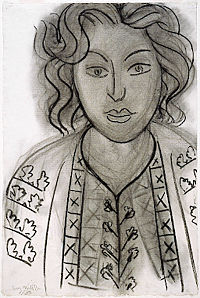Matisse: The Art Of Drawing
20
March - 30 May 1999

© Henri Matisse, 1938/Succession H. Matisse. Reproduced by permission of VISCOPY Ltd, Sydney 1999.
The celebrated French artist Henri Matisse (1869-1954) was a master draughtsman. The National Gallery of Australia is pleased to announce an exciting exhibition devoted to Matisse's art of drawing.
Matisse considered his drawing to be a very intimate means of expression. The method of artistic execution — whether it was charcoal, pencil, crayon, etcher's burin, lithographic tusche or paper cut — varied according to the subject and personal circumstance. His favourite subjects were evocative or erotic — the female form, the nude figure or a beautiful head of a favourite model. Other themes relate to the real or imagined world of both Oceania and the Carribean -- the lagoons, the coral and the faces of beautiful women from these far off lands. Still other subjects were inspired by classical mythology.
Much of Matisse's source of inspiration was poetic. Like his art, the poetry or poetic prose Matisse loved was intimate, sensuous and personal. In his later years Matisse developed the practice of reading poetry early each day before he raised a paint brush, pencil or etching needle. His sources were French medieval poetry of Charles d'Orléans and Pierre de Ronsard, as well as the more avant-garde writings of Stéphane Mallarmé, Henri de Montherlant, Louis Aragon and others. Matisse noted that poetry was like oxygen: ' just as when you leap out of bed you fill your lungs with fresh air.' This kept him young at heart — like a sensual elixir of youth.
The exhibition consists of one hundred drawings, original prints and illustrated books. This last art form included what Matisse called his 'flower books'. These were beautiful objects in themselves, inspired by the tradition of the Medieval manuscript. Faces, body parts, lovers, fruit and flowers reveal Matisse's exquisite arabesque lines, along with an extraordinary sense of colour. For the celebrated Jazz for instance, the images are characterised by brilliant colours, swirling lines and arabesques form series of jewel-like shapes, in themes which range from the circus to female forms amongst the sea. Matisse made his images from coloured stencils based on paper cut-outs. He developed this technique while bed-ridden and unable to create art, except with the most simple means, paper and scissors.
For this exhibition the National Gallery draws on its own rarely seen collection of drawings, prints and illustrated books, along with select loans from public and private collections. They reveal the artist as a master draughtsman who was able to achieve his stated desire to 'reconceive in simplicity' - words that aptly describe a lifetime's approach by Matisse to the art of drawing.
For further information,
please contact the exhibition curator, Jane Kinsman on telephone
(02) 6240 6406 or Public Affairs on telephone (02) 6240 6431 or fax (02)
6240 6561.
